Analysis of the Maximum Seismic Intensity Through the Theory of Extreme Values

Abstract
The objective of this study was to analyze the seismic behavior of the Pacific Region of Colombia. For the development of the study, local seismic magnitudes of the departments of Chocó, Valle del Cauca, Cauca, and Nariño were included between the years 1993 and 2018. In this sense, and through the extreme value theory, the maximum magnitudes in the seismic events that occurred were analyzed to obtain models that describe the behavior of the observations by using the method of maximum blocks and threshold exceedances, which allows the magnitudes to be associated of each of the departments to a type of distribution such as: Gumbel, Weibull or Frechet, from the Widespread Distribution of Values or Beta, Exponential or Pareto with use of the Generalized Pareto Distribution. The results obtained show return levels of 5.08, 6.03, 6.88 and 7.24 for the return periods of 2, 10, 50 and 100 years, respectively, for the department of Chocó using the maximum block method (Gumbel). Likewise, using the method of threshold exceedances (Exponential), it is estimated that, in 100 years, earthquakes of magnitude equal to or greater than 7.2 on the Richter scale may occur in Chocó.
Keywords
Extreme Values Theory, widespread Extreme Values Distribution, Widespread Pareto Distribution, Magnitude, Return Level
Author Biography
Jonathan Alfonso Pérez
Magister en Estadística Aplicada y Especialista en Analítica Estratégica de Datos con conocimientos en análisis de datos, modelos estadísticos y modelos predictivos de machine learning mediante el uso de lenguajes de programación (R y Python), herramientas de visualización, manejo de bases de datos (SQL), de igual forma Licenciado en matemáticas con experiencia docente en el área de matemáticas y estadística, líder reflexivo y crítico, con capacidad de diseñar, entender, gestionar estrategias de aprendizaje y promotor de trabajo en equipo con fines investigativos.
References
- J. Amaya (2012) “Gestión Del Riesgo Sísmico En Medellín”. Disponible en:
- http://bdigital.unal.edu.co/6595/1/79597260.15052012.pdf
- Comité AIS-300. Estudio General de Amenaza Sísmica de Colombia 2009, Asociación Colombiana de Ingeniería Sísmica, 2010.
- D. Muñoz (1989) “Conceptos básicos en riesgo sísmico. In Conceptos básicos en riesgo sísmico”, Física de la Tierra, Ed. Universidad Complutense de Madrid. Issue 1, pp. 199–216.
- C. Cárdenas, Y. Garzón, L. Santa, and L. Castillo, (2010). Modelo de Poisson para la ocurrencia y magnitud espacio temporal de los sismos en Colombia. UD y La Geomática, 4,28–43. Disponible en: http://revistas.udistrital.edu.co/ojs/index.php/UDGeo/article/view/3655/5257
- C. A. Cornell (1968) “Engineering seismic risk analysis”. Bulletin of the Seismological Society of America, Vol. 58(5). DOI: https://doi.org/10.1785/BSSA0580051583
- S. Coles (2001) “An Introduction to Statistical Modeling of Extreme Values”. Springer Series in Statistics. DOI: https://doi.org/10.1007/978-1-4471-3675-0
